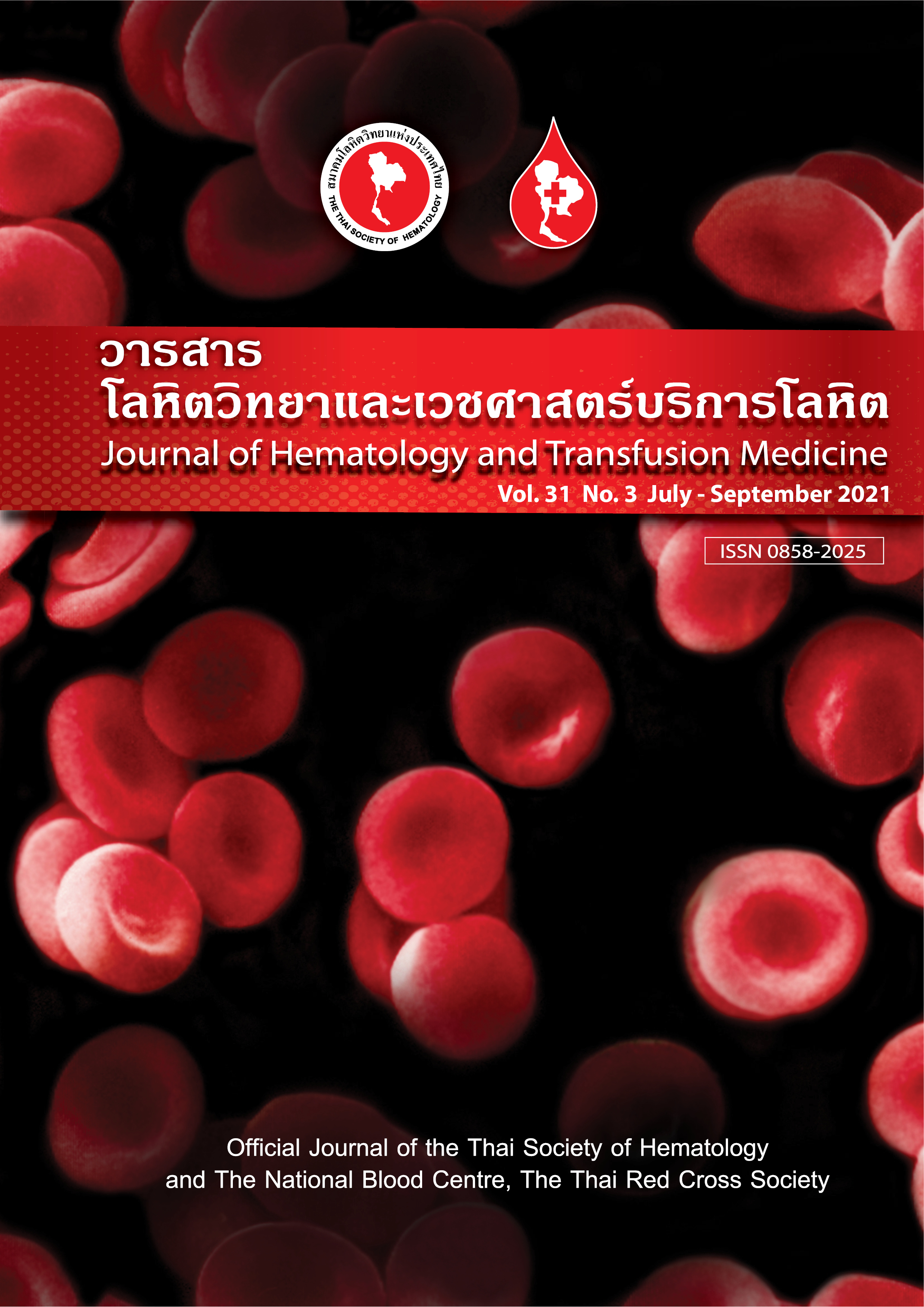Venous thromboembolism among Thai patients with lymphoma
Keywords:
Venous thromboembolism, Thai, patients, lymphomaAbstract
Background: Data remains limited regarding venous thromboembolism (VTE) among Thai patients with lymphoma.
Aims: The study aimed to determine the prevalence, predictive factors, and clinical outcomes of VTE among Thai patients with lymphoma.
Methods: The study employed a nested case-control design from a cohort of 1,769 lymphoma patients treated at Ramathibodi Hospital.
Results: The prevalence of VTE was 5.1% (91 patients). Locations of VTE were deep vein thrombosis of the lower extremities (53.9%), pulmonary embolism (23.1%), splanchnic vein thrombosis (5.5%), jugular vein thrombosis (3.3%), cerebral venous thrombosis (1.1%), and VTE in > 2 sites (13.1%). Among 41 patients (45.1%), VTE occurred during treatment or up to 3 months after completing therapy whereas among 35 patients (38.4%) VTE was diagnosed before therapy. A control group of 455 patients was randomly selected from the database of lymphoma patients without VTE. Of patients with VTE vs. controls, 51.6 vs. 49.0%, respectively, were female (p = 0.64). The mean age was 57 vs. 61 years (p = 0.09), respectively. Types of lymphoma in the corresponding groups were B-cell non-Hodgkin lymphoma (NHL; 93. vs. 78.9%), T-cell NHL (5.5 vs. 11.7%), and Hodgkin disease (1.1 vs. 6.4%), respectively (p = 0.02). Using multivariate analysis, B-cell NHL type (odds ratio [OR] 4.4), bulky mass >10 cm (OR 2.2) and prechemotherapy platelet count > 350 x 109/L (OR 2.1) were independently predictive factors of VTE. The mortality rate in the study and control groups was 25.3 and 15.8%, respectively (p = 0.03).
Conclusion: Prevalence of VTE among Thai patients with lymphoma is not low. B-cell NHL type, bulky mass, and elevated prechemotherapy platelet count were predictive factors of VTE. Patients with VTE exhibited higher mortality.
Downloads
References
Lauw MN, van Doormaal FF, Middeldorp S, Buller HR. Cancer and venous thrombosis: current comprehensions and future perspectives. Semin Thromb Hemost. 2013;39:507-14.
Angchaisuksiri P. Cancer-associated thrombosis in Asia. Thromb J. 2016;14(Suppl 1):26.
Caruso V, Di Castelnuovo A, Meschengieser S, Lazzari MA, de Gaetano G, Storti S, et al. Thrombotic complications in adult patients with lymphoma: a meta-analysis of 29 independent cohorts including 18,018 patients and 1,149 events. Blood.2010;115:5322-8.
Swerdlow SH, Campo E, Harris NL, Jaffe ES, Pileri SA, Stein H, et al. WHO classification of tumours of haematopoietic and lymphoid tissues. In: Bosman FT, Jaffe ES, Lakhani SR, Ohgaki H, eds. World Health Organization Classification of Tumours. Lyon, France: IARC; 2008.
Yokoyama K, Murata M, Ikeda Y, Okamoto S. Incidence and risk factors for developing venous thromboembolism in Japanese with diffuse large b-cell lymphoma. Thromb Res. 2012;130:7-11.
Park LC, Woo SY, Kim S, Jeon H, Ko YH, Kim SJ, et al. Incidence, risk factors and clinical features of venous thromboembolism in newly diagnosed lymphoma patients: results from a prospective cohort study with Asian population. Thromb Res. 2012;130:e6-12.
Siwasaranond N, Norasethada L, Tantiworawit A, Rattarittamrong E, Chai-adisaksopha C, Navwarawong W. Increased prevalence of thromboembolism events in Thai patients with lymphoma: the single center expreience from Maharaj Nakorn Chiang Mai Hospital. J Hematol Tranfus Med. 2013;23:33-41.
Kunawuttinankorn W, Tanyasaensook K, Rojnuckarin P. Incidence and risk factors for venous thromboembolism in Thai hospitalized lymphoma patients. Pharm Sci Asia. 2018;45(2):114-22.
Khorana AA, Kuderer NM, Culakova E, Lyman GH, Francis CW. Development and validation of a predictive model for chemotherapy- associated thrombosis. Blood. 2008;111:4902-7.
Ay C, Vormittag R, Dunkler D, Simanek R, Chiriac AL, Drach J, et al. D-dimer and prothrombin fragment 1+2 predict venous thromboembolism in patients with cancer: results from the Vienna Cancer and Thrombosis Study. J Clin Oncol. 2009;27:4124-9.



